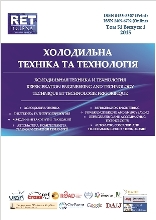ABOUT CORRELATION BETWEEN THE PERCOLATION RATE OF MOISTURE THROUGH THE SEMI-PERMEABLE MEMBRANES AND THE STANDARD MEASUREMENTS OF THEIR PERMEABILITY OR EVAPORATIVE RESISTANCE
DOI:
https://doi.org/10.15673/0453-8307.1/2015.36784Keywords:
Water vapour permeability – Standard test-methods – Moisture percolation rateAbstract
A variety of test methods to estimate the water vapour transmission (WVT)-rate of thin membranes do not provide, unfortunately, the reliable basis to compare the permeability of different fabrics. Their results are crucially dependent on the details and construction of experimental methodologies as well as on the accepted by the different authors conditions of measurement. In this work, we propose the universal approach and demonstrate its adequate realization to compare the transport properties of any semi-permeable membranes measured by the conventional test-methods. The purpose is to avoid any confusion in such procedure of comparison. We have analysed below the WVT-rates measured by six alternative test-methods, which have been applied step-by-step to six different fabrics. In opposite to the widespread search for a pair correlation between the above results obtained by any two methods we treat them, in total, for each fabric in terms of the reduced variables. This approach is based on the novel concept of the moisture percolation (MP)-rate which combines the diffusion and convective contributions in a transport process. It leads to the well-established general estimates of the normalized WVT-rates measured by the standard test-methods. Another advantage of the developed approach is its thermodynamic consistency, which offers the appropriate fluctuation model to take into account the porosity of any semi-permeable membranes.
References
ISO 11092 1993 “Textiles-Physiological Effects – Measurement of Thermal and Water Vapor Re-sistance under Steady-state Conditions (Sweating Guarded Hot Plate Test)” International Organization for Standardization, Geneva, Switzerland (1993). 2. ASTM E96, 1995. Standard Test Methods for Water Vapor Transmission of Materials in “Annual Book of ASTM Standards 4.06” American Society for Testing and Materials. West Conshohochen, PA, 1995. 3. ASTM F2298 2003. Standard Test Methods for Water Vapor Diffusion Resistance and Air Flow Re-sistance of Clothing Materials Using the Dynamic Moisture Permeation Cell in “Annual Book of ASTM Standards 11.03” American Society for Testing and Materials. West Conshohochen, PA, 2003. 4. ISO 15496 2004 “Test Measurement of Water Vapor Permeability of Textiles for the purpose of Quality Control” International Organization for Standardization, Geneva, Switzerland, 2004. 5. Huang J., X.Qian X. 2007, A new test method for measuring water vapor permeability of fabrics. Meas .Sci. Technol., 18(9): 3043-3047. doi:10.1088/0957-0233/18/9/040 6. Huang J., X.Qian X. 2008, Comparison of Test Methods for Measuring Water Vapor Permeability of Fabrics, Textile Research Journal, 78(4): 342-352. doi: 10.1177/0040517508090494 7. L.A.Grivtzova L.A., Gnevysheva I.V., Chyjkova L.F., Saytin B.V., 1980, About water vapor mecha-nism of permeability through hydrophobic porous materials, Kogevenno-obyvnaya promushlennost (KOP), 4: 48-49; 8. Chyjkova L.F., Gnevysheva I.V.,Grivtzova L.A., Tankova N.L., Shaposhnikova T.K., Saytin B.V., Kalashnikov V.G., 1980, Interconnection between sorption of moisture and permeability materials, (KOP), . 9: 47-50; 9. Grivtzova L.A., Gnevysheva I.V., Tankova N.L., Chyjkova L.F., Saytin B.V., 1980, Influence of po-rosity on permeability of polymer materials, (KOP), 10: 44-46.


